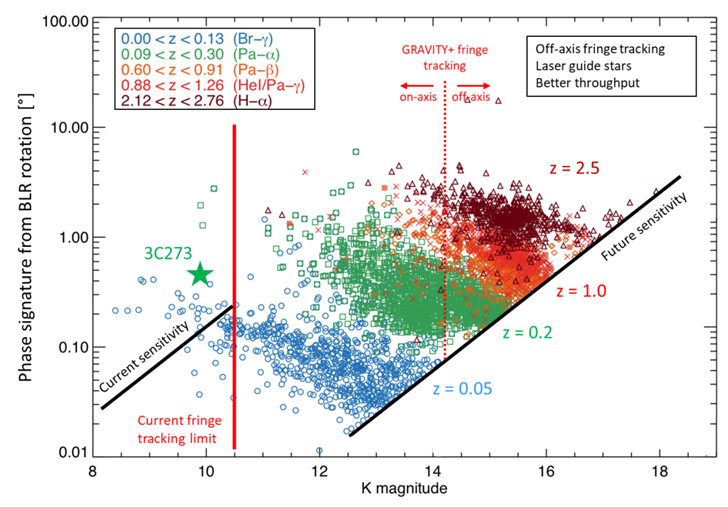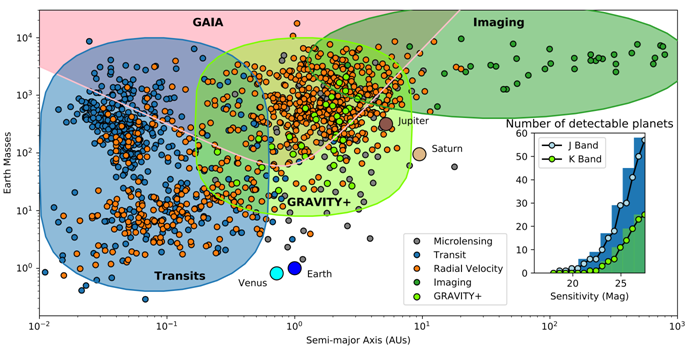The Galactic Centre
GRAVITY+ offers increased sensitivity and more stable performance compared with current low-order adaptive optics (AO) on natural stars only, thanks to the new extreme AO on laser guide stars (LGS). GRAVITY+ will therefore meet three objectives.
- study the very close environment of Sgr A* and its mass distribution, which according to the models should contain a population of stars fainter than the GRAVITY magnitude limit (K=19 in the deepest images), stellar remnants (including black holes) and small interstellar clouds ;
- test general relativity and measure the rotation rate of the black hole using the orbits of the stars detected ;
- study the structure of the magnetic field and gas movements near the last stable orbit.
Active nuclei of galaxies at high redshift
Almost all galaxies in the Universe host a supermassive black hole or SMBH (Super Massive Black Hole), with a mass between 106 and 1010 solar masses. This mass is closely correlated with the properties of the host galaxy (e.g. stellar velocity dispersion and bulge mass) although it represents only 1‰ of that of the galaxy. This common evolution between SMBH and galaxies provides information on the physical processes of the early phases of galaxy formation. However, our current understanding is based on scaling relations deduced by reverberation mapping in the local Universe for SMBHs of the order of 109 solar masses. The dynamical reverberation time is unobservable for more massive black holes and/or those subject to cosmological time dilation. The sky coverage and sensitivity of GRAVITY+ will allow access to several hundred SMBHs at a redshift (z) of about 0.3 ; a hundred at z between 0.8 and 1 ; and about 20 at z around 2.

These sources sample the growth peaks of black holes and star formation as well as the most luminous SMBHs. GRAVITY+ will thus become a true cosmological explorer, allowing to study super-Eddington accretion phenomena [1], tidal disruption events of stars and the “final parsec” problem [2].
Exoplanet characterisation
The current composition of exoplanet atmospheres contains traces of their mode of formation and evolution (Madhusudhan 2019). Yet, intense efforts with traditional techniques (transit spectroscopy and direct imaging) have only been able to determine their chemical abundances to within an order of magnitude (e.g. Kreidberg et al. 2014). The combination of extreme AO and interferometry in GRAVITY+ will make it possible to study the dozen or so known young exoplanets in depth and achieve several objectives. Firstly, to measure their respective masses using the data made available in the catalogue drawn up by the Gaia mission (ESA), then by studying their radial velocities and/or their gravitational perturbations. Secondly, to study their brightness by direct detection of their intrinsic thermal emissions. Thirdly, to determine their chemical composition using K-band spectroscopy. The publication of Gaia DR4 will provide several dozen other young exoplanets with low separation (and therefore not detected by AO imaging) but accessible to GRAVITY+.

The Mass/Luminosity/Metallicity/Age diagrams thus constructed will be invaluable markers of the physical processes of formation. Finally, the contrast/separation domain accessible to GRAVITY+ could enable us to detect a few mature exoplanets in reflected light and similar to Jupiter. Such detections could reorientate the way in which the community plans to detect and characterise exo-Earth in the distant future.
Banner image credits : ESO/Luis Calçada
[1] Accretion phenomena where the Eddington limit is exceeded, i.e. when the radiation pressure of light overcomes gravity, dragging matter with it.
[2] How a pair of SMBHs formed by the collision of two galaxies can dissipate angular momentum when their separation is of the order of a parsec.

